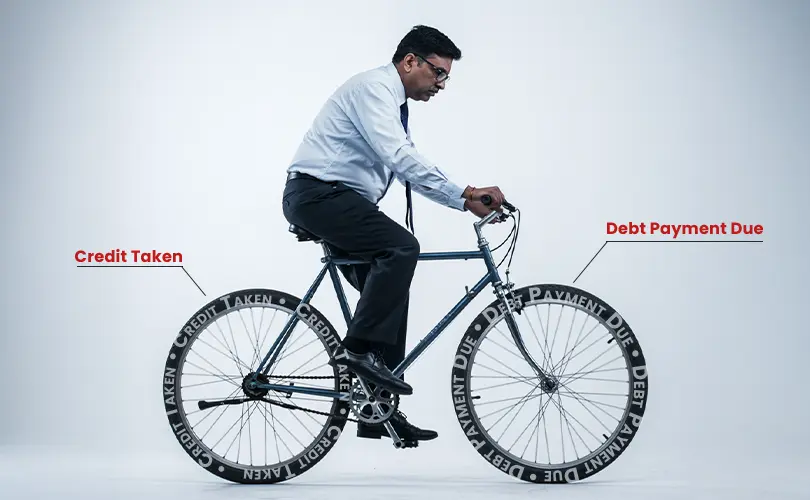

Do you find it challenging to make your salary last through the month? You’re not alone! Many people in India struggle to break free from this pattern, constantly relying on credit cards, easy loan apps, or Buy Now Pay Later (BNPL) schemes to cover their expenses. The reality is, without a solid financial strategy, the debt trap can quickly spiral out of control.
A recent report by BUSINESSWORLD highlights that over 53% of middle-class Indians struggle with mounting debt, primarily due to uncontrolled spending and high-interest loans. But the good news is, escaping the debt cycle is entirely possible—with the right plan.
In this article, we’ll explore practical, long-term strategies to break free from the monthly debt trap and regain control over your financial health.
A debt trap is when you keep borrowing money to pay off existing debts or to manage regular expenses. This happens due to:
These issues push people deeper into a cycle where they earn, spend, borrow, and repeat, never truly becoming financially free.
A budget isn’t just a set of numbers on a spreadsheet—it’s your personal financial GPS, guiding you toward stability and long-term security. Without a proper budget, it’s easy to lose track of where your money is going, leaving you scrambling to cover expenses or falling into a cycle of borrowing. Budgeting isn’t about restricting yourself from enjoying life; it’s about ensuring that you have control over your money, rather than your money controlling you.
Think of your budget as a well-planned diet for your finances. Just like eating mindlessly can lead to health issues, spending without a clear plan can result in debt accumulation, financial stress, and a lack of savings. A well-structured budget helps you prioritize essential expenses, eliminate wasteful spending, and work towards financial goals—whether that’s debt repayment, an emergency fund, or future investments.
Raj, a Freelancer, used to struggle with credit card debt every month. By implementing the 50/30/20 rule and tracking expenses, he reduced unnecessary spending by ₹5,000 per month, using that amount to clear debts instead. Within a year, he not only paid off a significant portion of his credit card dues but also built a small emergency fund.
Bottom line: A budget isn’t a restriction—it’s financial freedom in disguise. It allows you to enjoy life without the guilt of overspending and ensures that your money is working for you, not against you. If you don’t plan where and how your money should be spent, it will disappear before you even realize it.
Impulse buying is one of the biggest reasons people keep falling into debt. Online shopping, discount deals, and BNPL offers make it easy to spend now and worry later.
Impulse buying isn’t just a spending habit—it’s a psychological reaction. The thrill of snagging a limited-time deal, the rush of adding items to the cart, the instant gratification of a purchase—these are all tied to our brain’s reward system. Every time you shop impulsively, your brain releases dopamine, the “feel-good” chemical, which creates a sense of happiness. However, this pleasure is temporary, and once it fades, many people experience buyer’s remorse or financial stress.
Retailers and online platforms exploit this psychological trigger. Flash sales, countdown timers, “Only 2 left in stock” alerts, and Buy Now Pay Later (BNPL) schemes are all designed to manipulate emotions, creating a false sense of urgency. The result? You end up spending on things you don’t need, often with money you don’t have.





Example: Neha used to fall for every Big Billion Days sale, spending thousands on unnecessary items. By implementing the 24-hour rule, she saved ₹15,000 in three months.
Credit cards, payday loans, and personal loans often have interest rates as high as 36% per annum. If you only pay the minimum amount due, your debt keeps growing.



Example: Vikram was struggling with multiple loans, each with a steep 20% interest rate. Despite making payments, mounting penalties and late fees kept him trapped in debt. That’s when he turned to SingleDebt’s Debt Management Plan (DMP). Their experts restructured his debts into a single, affordable monthly EMI, negotiated with lenders to reduce penalties, and helped him regain financial stability. With a clear repayment strategy, Vikram finally saw a path to a debt free future.
Many people take loans just to cover unexpected expenses like medical emergencies, car repairs, or job loss. This can be avoided with an emergency fund. But where you keep your emergency fund is just as important as building it. You need a place that provides liquidity (easy access when needed), security (no risk of loss), and, ideally, some interest earnings to keep your money growing.
Unlike regular savings accounts, high-yield savings accounts offer better interest rates (often 3%–7% in India), allowing your emergency fund to grow while staying accessible. Look for accounts with no penalties on withdrawals.
Best for: Short-term emergencies like medical bills or urgent car repairs.
Fixed Deposits (FDs) offer higher interest (up to 7.5%) but usually have penalties on early withdrawals. A “sweep-in” FD links your savings account to an FD, letting you withdraw when needed without losing interest.
Best for: Medium-term emergencies, like job loss or major home repairs.
These funds invest in short-term government securities and corporate bonds, offering returns of 5%–7% while allowing withdrawals within 24 hours. Unlike stocks, they are low-risk and less volatile.
Best for: Those who want slightly better returns without locking money for long.
If you’re still building your emergency fund, a Recurring Deposit (RD) helps instill financial discipline by automatically transferring a fixed amount every month. RDs offer higher interest than savings accounts (6%–7%) while keeping your money safe.
Best for: Gradually building an emergency fund from scratch.
Example: Ramesh saved ₹1,000 per month for a year. When his bike broke down, he used his savings instead of swiping his credit card, avoiding new debt.
Credit cards can be useful but also dangerous if not managed correctly. Many people end up in a debt trap by overspending on credit and only paying the minimum due, leading to mounting interest.
Example: Priya switched from using credit cards for daily expenses to using her debit card. This reduced her credit card bill by 60% in just two months.
Avoiding the debt trap is about making small, consistent financial changes. Start by budgeting, cutting unnecessary expenses, reducing high-interest debt, and saving for emergencies.
If you’re already in deep debt, services like SingleDebt’s Debt Management Plan (DMP) can consolidate your debts, lower interest rates, and stop creditor harassment. Remember, the key to financial independence is smart planning and disciplined spending.
Ready to break free from the debt cycle? Start today and take charge of your financial future!













